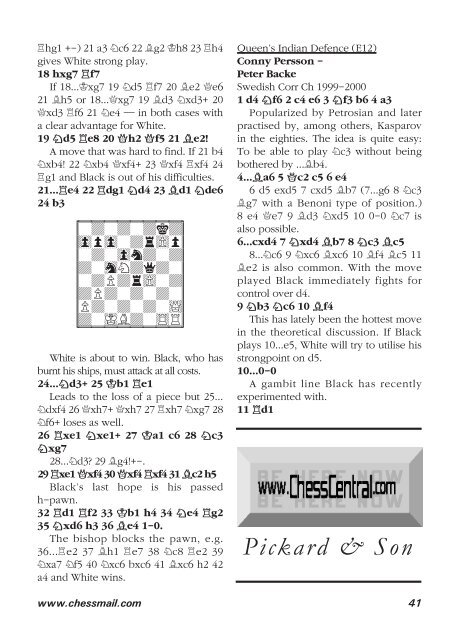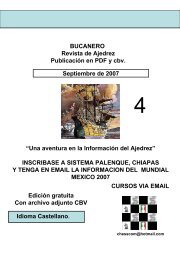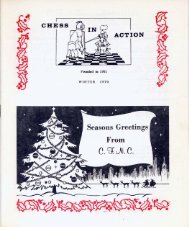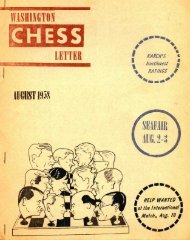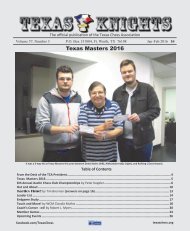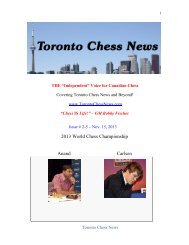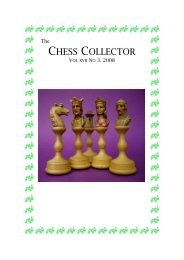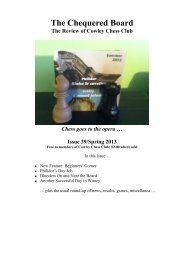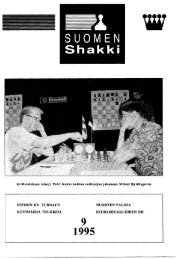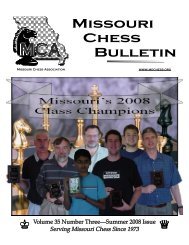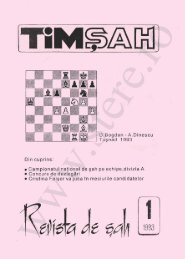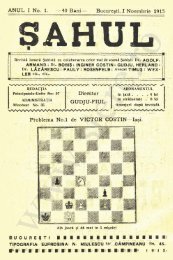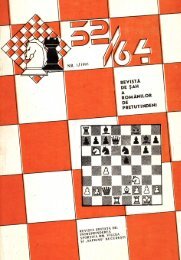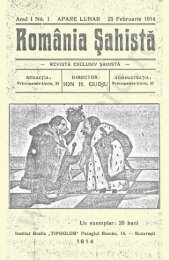Chess Mail
El ajedrez es un juego, considerado un deporte, entre dos personas, cada una de las cuales dispone de 16 piezas móviles que se colocan sobre un tablero dividido en 64 escaques. En su versión de competición está considerado como un deporte.
El ajedrez es un juego, considerado un deporte, entre dos personas, cada una de las cuales dispone de 16 piezas móviles que se colocan sobre un tablero dividido en 64 escaques. En su versión de competición está considerado como un deporte.
Create successful ePaper yourself
Turn your PDF publications into a flip-book with our unique Google optimized e-Paper software.
¦hg1 +-) 21 a3 ¤c6 22 ¥g2 ¢h8 23 ¦h4<br />
gives White strong play.<br />
18 hxg7 ¦f7<br />
If 18...¢xg7 19 ¤d5 ¦f7 20 ¥e2 £e6<br />
21 ¥h5 or 18...£xg7 19 ¥d3 ¤xd3+ 20<br />
£xd3 ¦f6 21 ¤e4 — in both cases with<br />
a clear advantage for White.<br />
19 ¤d5 ¦e8 20 £h2 £f5 21 ¥e2!<br />
A move that was hard to find. If 21 b4<br />
¤xb4! 22 ¤xb4 £xf4+ 23 £xf4 ¦xf4 24<br />
¦g1 and Black is out of his difficulties.<br />
21...¦e4 22 ¦dg1 ¤d4 23 ¥d1 ¤de6<br />
24 b3<br />
XIIIIIIIIY<br />
9-+-+-+k+0<br />
9zppzp-+rzPp0<br />
9-+-zpn+-+0<br />
9+-snN+q+-0<br />
9-+P+rzP-+0<br />
9+P+-+-+-0<br />
9P+-+-+-wQ0<br />
9+-mKL+-tRR0<br />
xiiiiiiiiy<br />
White is about to win. Black, who has<br />
burnt his ships, must attack at all costs.<br />
24...¤d3+ 25 ¢b1 ¦e1<br />
Leads to the loss of a piece but 25...<br />
¤dxf4 26 £xh7+ £xh7 27 ¦xh7 ¤xg7 28<br />
¤f6+ loses as well.<br />
26 ¦xe1 ¤xe1+ 27 ¢a1 c6 28 ¤c3<br />
¤xg7<br />
28...¤d3? 29 ¥g4!+-.<br />
29 ¦xe1 £xf4 30 £xf4 ¦xf4 31 ¥c2 h5<br />
Black’s last hope is his passed<br />
h-pawn.<br />
32 ¦d1 ¦f2 33 ¢b1 h4 34 ¤e4 ¦g2<br />
35 ¤xd6 h3 36 ¥e4 1–0.<br />
The bishop blocks the pawn, e.g.<br />
36...¦e2 37 ¥h1 ¦e7 38 ¤c8 ¦e2 39<br />
¤xa7 ¤f5 40 ¤xc6 bxc6 41 ¥xc6 h2 42<br />
a4 and White wins.<br />
www.chessmail.com<br />
Queen’s Indian Defence (E12)<br />
Conny Persson -<br />
Peter Backe<br />
Swedish Corr Ch 1999-2000<br />
1 d4 ¤f6 2 c4 e6 3 ¤f3 b6 4 a3<br />
Popularized by Petrosian and later<br />
practised by, among others, Kasparov<br />
in the eighties. The idea is quite easy:<br />
To be able to play ¤c3 without being<br />
bothered by ...¥b4.<br />
4...¥a6 5 £c2 c5 6 e4<br />
6 d5 exd5 7 cxd5 ¥b7 (7...g6 8 ¤c3<br />
¥g7 with a Benoni type of position.)<br />
8 e4 £e7 9 ¥d3 ¤xd5 10 0–0 ¤c7 is<br />
also possible.<br />
6...cxd4 7 ¤xd4 ¥b7 8 ¤c3 ¥c5<br />
8...¤c6 9 ¤xc6 ¥xc6 10 ¥f4 ¥c5 11<br />
¥e2 is also common. With the move<br />
played Black immediately fights for<br />
control over d4.<br />
9 ¤b3 ¤c6 10 ¥f4<br />
This has lately been the hottest move<br />
in the theoretical discussion. If Black<br />
plays 10...e5, White will try to utilise his<br />
strongpoint on d5.<br />
10...0–0<br />
A gambit line Black has recently<br />
experimented with.<br />
11 ¦d1<br />
Pickard & Son<br />
41


